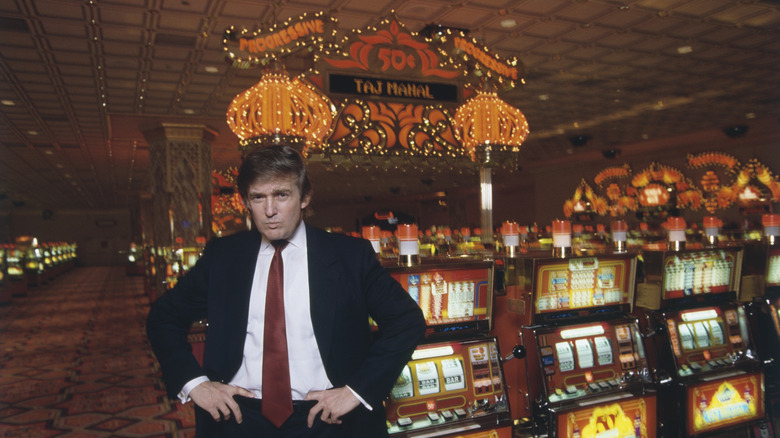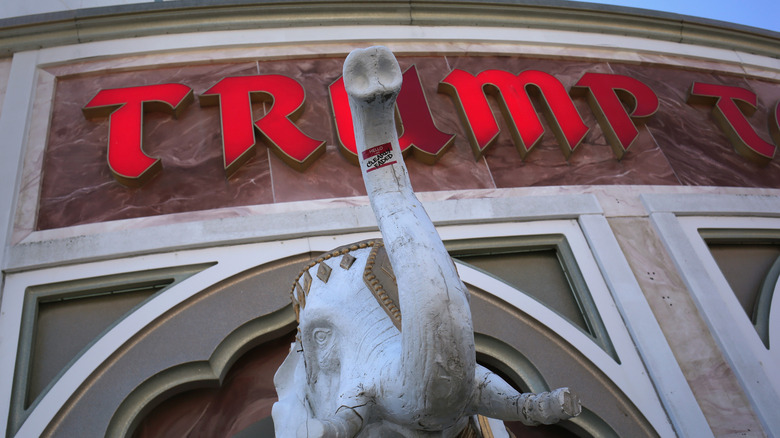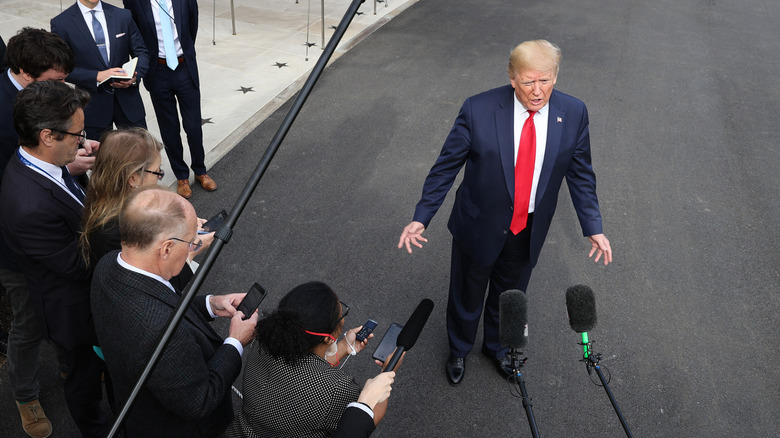All Of The Times That Donald Trump Went Into Bankruptcy (And How He Recovered)
Of the many publicly known unsavory elements of Donald Trump's past, his bankruptcies, in particular, have been cited as key reasons to question his economic policies. While Trump has never filed for personal bankruptcy, he has filed for corporate bankruptcy a whopping six times.
Despite the fact that Trump has previously claimed that his past bankruptcies were not his personal responsibility, the reality is a bit different. He told Forbes in 2011, "I've cut debt — by the way, this isn't me personally, it's a company." However, his first bankruptcy in 1991 did leave him personally liable for a portion of the debt attributed to his Taj Mahal casino in Atlantic City. In fact, Trump was found personally liable for around $900 million of the casino's debt due to his using junk bonds with high interest rates to finance the initial construction of the casino. In the restructuring agreement for this first bankruptcy, Trump was forced to sell his 220-foot Trump Princess yacht, an airline he owned, and half of his ownership in the Trump Taj Mahal company.
However, instead of learning this lesson from this initial bankruptcy, Trump went on to declare bankruptcy many more times, taking advantage of loopholes and restructuring policies to avoid debt. Trump also told Forbes, "Basically I've used the laws of the country to my advantage... just as many, many others on top of the business world have." While this may be a true statement in the world of business, as a now-second-term President, it could leave consumers financially worried.
Trump's bankruptcies
Of Donald Trumps' six bankruptcies, all but one was tied to his casino and hotel properties in Atlantic City, New Jersey. These gambling and hospitality properties, founded under the name Trump Hotels & Casino Resorts in 1995 (and rebranded under the name Trump Entertainment Resorts in 2004 following yet another bankruptcy) faced ongoing financial problems. It's worth mentioning that as of 2016, none of the properties that fell under the umbrella of Trump Entertainment Resorts are open or owned by the company anymore.
Just one year after Trump first declared bankruptcy for his Trump Taj Mahal casino, he declared bankruptcy a second and third time for different properties. The first was Trump Castle, another Atlantic City gambling hall that, ironically, faced major competition from Trumps' Taj Mahal. As part of the bankruptcy agreement, Trump gave up his 50% share in the casino in exchange for lower interest rates on the casino's $338 million in bonds. Also in 1992, Trump filed for bankruptcy on yet another Atlantic City property, the Trump Plaza Hotel and Casino. Trump's fourth bankruptcy was for the Plaza Hotel in Manhattan. After this bankruptcy, Trump technically remained the hotel's CEO, however the reality was that he earned no salary and had no actual operational authority over the hotel.
Trump's fifth and sixth bankruptcies centered yet again on his casino and resort corporation. After the sixth, in 2009, Trump parted ways with Trump Entertainment Resorts, with the company going on to file bankruptcy yet again in 2014 and folding completely in 2016.
How Trump recovered
Each corporate bankruptcy has required concessions from Donald Trump as part of the restructuring process. Perhaps the most common was that Trump had to give up his own stake in the company as part of its financial restructuring. In his first and second corporate bankruptcies, he gave up 50% of his stake in each company. During his fourth bankruptcy, Trump gave up 49% of his stake in the Plaza Hotel. Finally, during the fifth bankruptcy Trump had to reduce his 47% stake in his casino company to just 27% before reducing it even further (to 10%) during the sixth bankruptcy. However, these concessions allowed for lower interest rates and restructured debt that kept his companies going.
An important thing to keep in mind is how easy it is to conflate personal bankruptcy and corporate bankruptcy when it comes to Trump's specific naming convention. As Michael Viscount, a lawyer with Fox Rothschild LLP (the firm that represented creditors during the Trump Hotel and Casino's 2004 Chapter 11 filing) explained to Forbes, "Corporations, limited partnerships, and LLCs in which he had an ownership interest or companies that had his name attached have filed for bankruptcy. Therein lies the big distinction." Trump's use of his own name within his corporation's names has made it easy for consumers to assume his business bankruptcy filings were personal ones. However, after his first 1991 bankruptcy (in which he was found financially liable), he stopped guaranteeing any future debt with his own wealth. This has kept his personal liability nonexistent on subsequent corporate bankruptcies.


